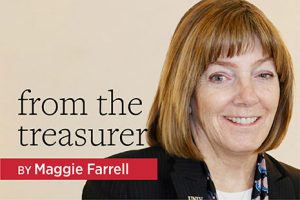
It is mid-autumn as I write this column. I’ve had a spate of trips this fall: visits with family and friends for milestone birthdays; the terrific American Association of School Librarians conference in Tampa, Florida; the ALA Executive Board fall meeting in Chicago; and the endowment trustees meeting in Washington, D.C.
I’ve shifted from lightweight outfits to the heavier sweaters of the season. Autumn is, after all, a time of transition—which is something our Association is currently experiencing.
Transition can be unsettling, yes, but it is also an opportunity to step back, take stock, and lay the foundation for what will follow. As we work with our interim executive director at the helm and look to the recruitment and eventual arrival of a new executive director, let’s consider three key aspects of the Association’s finances.
First, there are our successes. Overall, ALA closed FY2023 with significantly higher short-term investments—an indication of liquidity—than in the previous fiscal year, as well as a shrinking loan balance. Contributed revenue (such as donations and grants) was a boon to the Association in the past fiscal year, accounting for almost one-quarter of revenues. Meanwhile, ALA staff members have been vigilant about managing expenses, keeping them below budget in many divisions, round tables, and other units such as Continuing Education. These have been successes worth celebrating, and more importantly, successes for us to build on.
Transition can be unsettling, yes, but it is also an opportunity to step back, take stock, and lay the foundation for what will follow.
Second, there are the trends we need to keep an eye on. For instance, although the Association continues to draw significant revenue from established sources like conferences, membership, and publishing, some of these units have struggled in recent years to bring a net surplus and provide overhead contributions. Of particular note are the numbers from the 2023 LibLearnX conference in New Orleans, which lagged expectations. Membership growth, meanwhile, has been slower than expected, and total counts remain below prepandemic levels. Because a large proportion of ALA revenue derives from these sources, the Executive Board will continue to monitor them closely.
Third, there are the areas with potential for change. Managing expenses, an area of success already noted, is sound practice, but we need a stronger push toward generating additional revenue that extends beyond donations and grants. While contributed revenue may have helped bolster our financial stability in recent years, it is difficult to sustain at such levels over time. As a result, we continue to keep an eye on areas that may inform future adjustments. For example, what will LibLearnX in Baltimore tell us about the continued financial viability of that conference? Other strategic priorities include growing our membership and growing our endowment. ALA’s Chief Financial Officer Dina Tsourdinis and her team in the finance and accounting office deserve recognition for their collaboration in keeping the Association moving forward.
This transitional period should spur us to think about possibilities for scaffolding the work of ALA with the support that’s needed. The Association’s financial situation is not precarious, but as a Board we must remain attentive and create an environment that enables new staff leadership to continue building momentum and plan for changing course where necessary.
Transitions allow for the opportunity to reflect and reassess. Let’s continue to celebrate the wins and take the steps needed to make the Association as strong as ever.


